Introduction
Not so many years ago, the word ‘brand’ referred exclusively to the company logo, tag line, and other visual representations. Today, top corporate brands absorb and present the sum of a company’s values and behaviors within a corporate brand persona. The brands become evocative of a unique business approach and a style that represent a guarantee for engagement. Top brands are single-minded and clear about their promise as their strategic intent is to deliver the benefits promised. It is now widely recognized that the brand is a mission-critical asset, requires relevancy, and needs continual nourishment and modernization within an ever-changing business environment and economy.
Many businesses view corporate branding and corporate identity as two interchangeable marketing activities, which is plausible given the confusion in their definition and use. Although these terms appear to be similar, though, they are two very distinct concepts and typically mistakenly used in marketing practice. The corporate brand represents the market’s intangible perception of the business driven by their emotive connection with the company. In contrast, corporate identity is concerned with how the company wants to be perceived by the market as promoted within their unique visual appearance and content. It is essential to understand that the brand creates the business story, and corporate identity proceeds to tell the story in an array of promotional and communication venues.
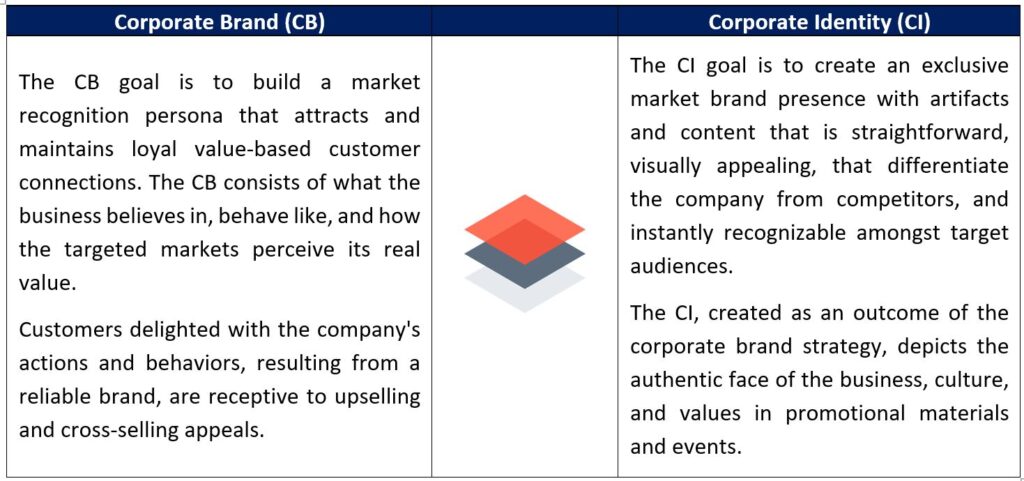
“When people use your brand name as a verb that is remarkable.”
Meg Whitman
The value of a powerful brand extends beyond the marketing activities as branding provides strategic clarity and actions across the total business enterprise. A strong brand fosters awareness, creates brand loyalty and trust, motivates employees, and builds a clan culture.
Branding has the power to shape perceptions because human behaviors are highly vulnerable to stimuli obtained both consciously and unconsciously. How consumers perceive a brand substantially influences their engagement with a business entity. In daily life, there is a recognition that perception is reality, and that is the real power of branding. A marketing strategy targeting consumers’ reality by swaying purchasing behavior is a blueprint for market success.
Most people can quickly identify with the top brands. For example, consumers prefer iPhones over the competition, with Apple’s recognized quality and support, and favor Amazon with its user-friendly online marketplace that caters to consumer preferences. Like many great brands, these companies are proactively attempting to influence human perceptions continually.
Presented below is an outline of Microsoft’s appealing brand strategy consisting of emotion-based story points that reinforce its highly-attractive brand among targeted audiences.
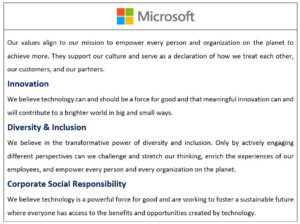
The forward-thinking, seamless experience of the Microsoft brand has become an inextricable part of the identities of a legion of devoted followers. For this reason, its brand is Microsoft’s ultimate competitive advantage. A long-standing truism is that a well-recognized brand, supported with excellent corporate identity material, is the synthesis of savvy business leadership, outstanding products, supporting strategic initiatives and infrastructure, and relevant differentiation.
“Too many companies want their brands to reflect some idealized, perfected image of themselves. As a consequence, their brands acquire no texture, no character and no public trust.”
Richard Branson
Corporate Brand Strategy Model
Brand owners are responsible for ensuring that their brands are healthy and remain growing. An unbiased approach for evaluating brand performance is, therefore, indispensable. The development of the corporate brand and identity strategies should be organized and managed within a structured framework integrated with the enterprise strategy. As the brand persona represents a fusion of all aspects of the corporate environment, all pertinent stakeholder insights and strategic decisions and initiatives need to be accountable within the brand design. Likewise, corporate identity requires transparency and alignment with the same organizational elements.
Shown below is an example of a generic model to support the multi-stage creation and the feedback loop of a corporate brand strategy, within the enterprise marketing strategy.
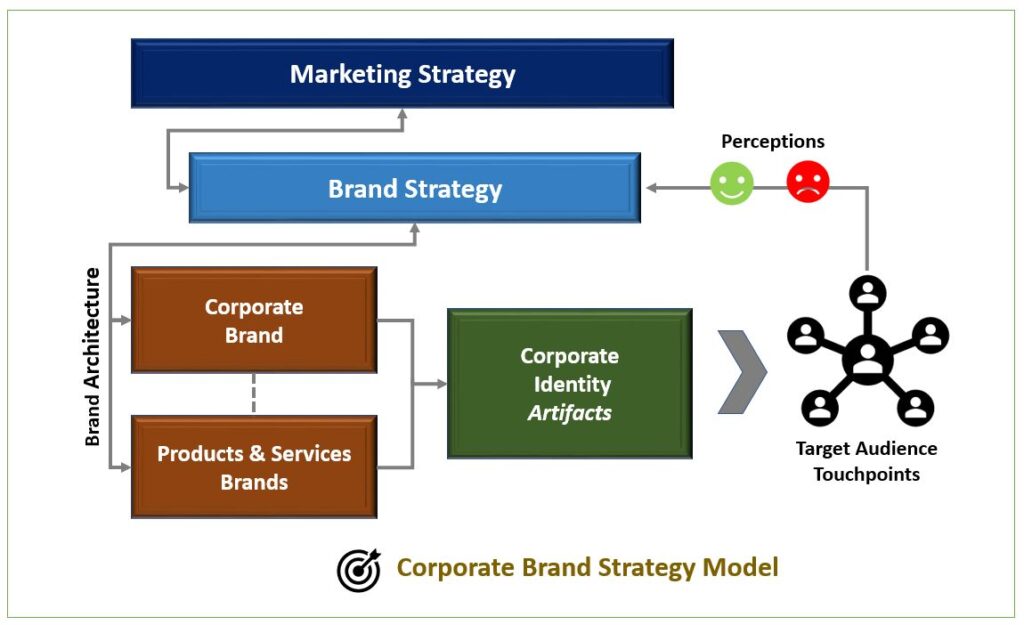
A formal strategic association exists among corporate brand and corporate identity activities with their shared linkage to the company’s brand strategy. Commonly, the branding strategy, established as a marketing sub-strategy, comprises corporate brand and discrete products and services brands management programs aligned within the enterprise Brand Architecture. The branding process does not conclude with the brand baseline and launch. It never ends as branding is an ongoing improvement undertaking for a successful business!
Strategically, changes to the corporate and individual brands necessitate corresponding improvements to the corporate identity materials. Targeted audience (customer and non-customer) touchpoints provide the means for the dissemination of the corporate identity artifacts. The market reactions expressed as perceptions of the degree of the value supplied by the business offer insights to the potential update of the corporate and individual brands and corporate identity.
”So, what’s your message? Can you say it easily? Is it simple, relevant, and repeatable? Can your entire team repeat your company’s message in such a way that it is compelling? Have new hires been given talking points they can use to describe what the company offers and why every potential customer should buy it?”
Donald Miller
Brand Equity and Brand Strength
Brand strength and brand equity are similar but not the same. Brand equity describes a brand’s value determined by consumer perception of and experiences with the brand. If consumers think highly of a brand, it has positive brand equity, and businesses can command higher pricing. Brand strength consists of specific measures that define a powerful brand and allows the development of supporting strategies and actions to strengthen the brand.
A Brand Strength Analysis assesses the capability of a corporate entity to create loyalty and sustainable product and services demand and profit for a future period. Interbrand defines the Brand Strength analysis as a best practice based on the evaluation of ten factors they believe to constitute a strong brand. The assessment includes analysis among competitive industry brands and comparable to other world-class brands. The result is a discerning snapshot of the brand’s strengths and weaknesses used to produce a road map of activities to strengthen the brand’s market power and value into the future. Shown below are Interbrand’s ten brand strength factors.
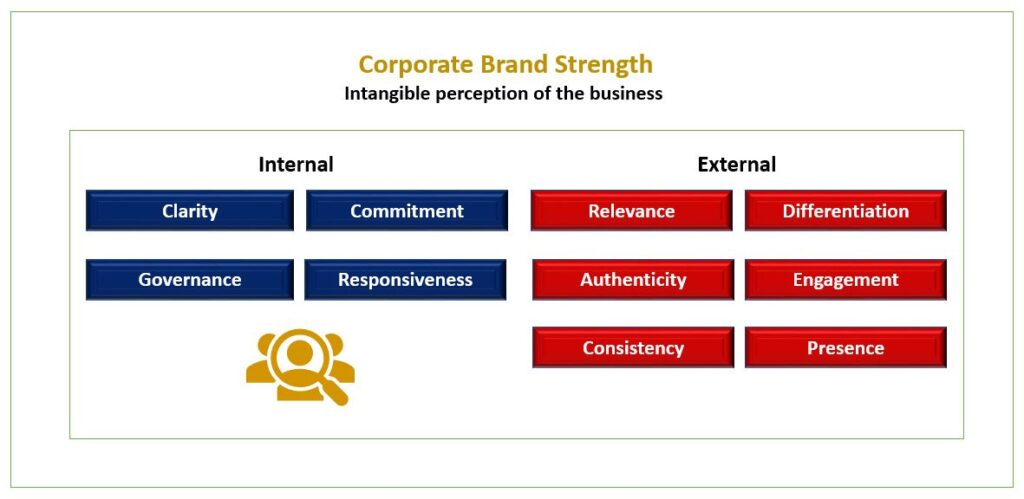
“Your brand is what other people say about you when you’re not in the room.”
Jeff Bezos
Brand Valuation and Evaluation
As consumers, judgment, and valuation is something we instinctively do in our shopping activities. It is much easier to accept the premise that ‘seeing is believing’ when assessing something visually. However, when it comes down to appraising a business, it is what you do not see that is most critical to valuation.
A brand can be valued at any time and for many different reasons, involving brand strategy, financial reporting, mergers and acquisitions, and litigation.
Valuation and Evaluation: Definitions
The terms’ brand valuation’ and ‘brand evaluation’ are analogous, but represent two very different business measurement practices. Brand valuation is narrower and limited to monetary considerations, whereas brand evaluation encompasses both non-monetary and financial elements.
Brand Valuation
Brand valuation estimates the value that represents the financial equity the company has in the brand as a transferable asset. This practice presents a challenge when using only conventional accounting standards in working with intangible assets.
Brand Valuation is the brand owner’s point of view.
ISO 10668, Brand Valuation – Requirements for Monetary Brand Valuation focuses on an approach and measures for brand financial valuation.
Brand Evaluation
Brand evaluation is a measure of brand strength, in conventional terms, how ‘strong’ the brand is, and the influence it has on stakeholders’ actions and is a critical input to brand valuation, which centers on the monetary value. The evaluation approach takes into account non-financial considerations as well as financial factors such as sales, profit, and ROI.
Brand Evaluation is the brand stakeholder’s point of view.
ISO 20671, Brand Evaluation – Principles and Fundamentals consists of a set of technical requirements and methods to measure a brand’s strength for both non-monetary and monetary considerations.
ISO 10668 (Valuation) Summary
ISO 10668:2010 specifies a framework for brand valuation, including objectives, the basis of valuation, approaches to valuation, methods of valuation, and sourcing of quality data and assumptions. It also specifies methods for reporting the results of such an assessment.
ISO 10668 provides the opportunity to select from a range of valuation approaches and methods. There are three valuation approaches including, Income Approach, Market Approach, and Cost Approach. Within each plan, there is an array of applicable supporting methods. The objective of the brand valuation, characteristics of the brand and market, and availability of data will influence the selection of the most appropriate method for a specific assessment.

Market Approach
The market approach calculates the value based on what other purchasers, in the market, have paid for assets considered reasonably similar to those valued. The market approach results in an estimate of the price reasonably expected to realize for the brand sale. Data on the price paid for reasonably comparable brands are collected, and adjustments made to compensate for differences between those assets and the brand. For selected comparables, multiples are computed based on their acquisition price and applied to the aggregates of the subject brand.
Cost Approach
The cost approach calculates the value of a brand based on the cost invested in building the brand, or its replacement or reproduction cost. The actual cost invested in the brand comprises all costs expended on building and protecting the brand up to the value date. The cost to replace the brand includes the cost of constructing a similar brand of equivalent utility at prices applicable at the time of the valuation analysis. The reproduction cost represents the cost incurred, at the value date, to recreate a similar brand with adjustment to take into account potential losses of awareness and strength.
Income Approach
The income approach calculates the brand value by reference to the present value of the economic benefits projected received over the remaining useful brand economic life. The actions in conducting this approach include estimating the expected after-tax cash flow streams attributable to the asset over its remaining useful economic life and converting these after-tax cash flow streams to present value (PV) through discounting with appropriate discount rate.
ISO 20671 (Evaluation) Summary
ISO 20671 specifies the fundamentals and principles for brand evaluation, including an integrated framework for brand evaluation containing necessary brand input elements, output dimensions, and sample indicators and forms the basis for other, more specific standards for development.
ISO 20671 targets at all business types desiring to increase their brand value and provides a starting point for high-level planning and governance, including best practices for brand management and brand reporting. It provides a more holistic view, covering non-financial as well as financial measures.
The framework has three parts, as shown below. Each part calls for identifying the value of a brand in a specific way. Each section builds on the prior part effort in moving from evaluating the brand from the stakeholder to the entity’s point-of-view. It identifies input elements used to develop brands and output dimensions that assess brand strength, which supports brand performance, financial results, and, ultimately, brand valuation.
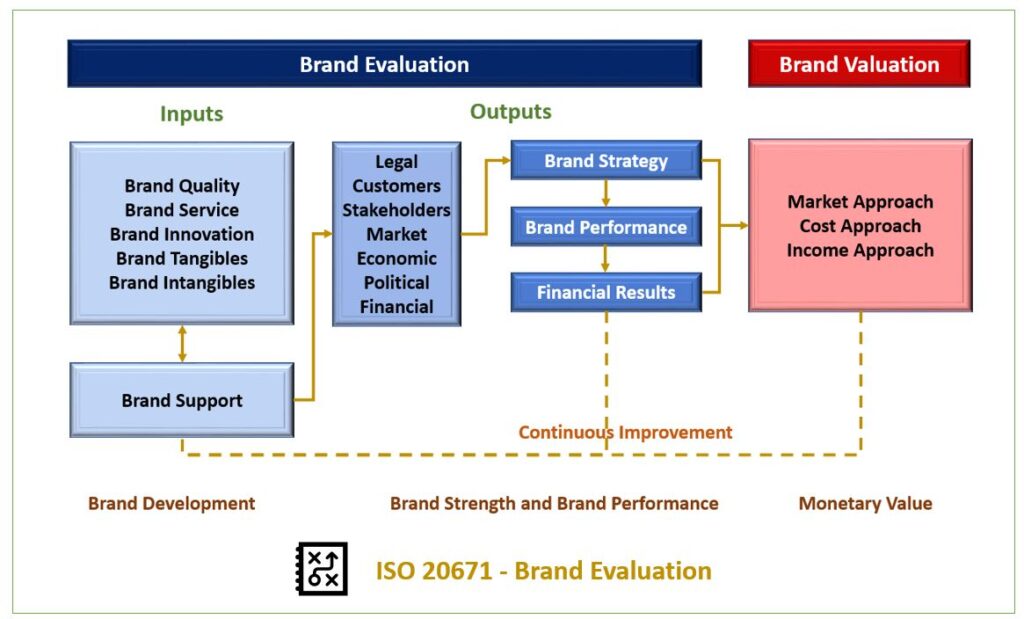
The brand evaluation uses a range of applicable pointers, including:
- Diagnostic measures to guide why the brand is evolving versus plan.
- Overall strength and reputation of the brand in targeted markets.
- Strengths and weaknesses of particular brand components that impact the effectiveness of the corporate identity program.
- The motivation of the brand values on the perceptions and actions of customers and other stakeholders.
The completion of the successful use of ISO 20671 for brand evaluation is not possible without the inclusion of the three parts of the framework, including the element associated with ISO 10668.
“Applying ISO 20671 creates a feedback loop for the continuous improvement of a brand that leads to greater value for the entity over time. By investing (changing the composition and level of brand input elements) based on such feedback, brands can be improved to provide greater benefits and better experiences to customers and other stakeholders and higher returns on the brand asset to the entities which use and own the brand.”
Marketing Accountability Standards Board
Top Brands Strengths Examples
The value of a corporate brand can be challenging to translate to a balance sheet due to its intangible composition. Interbrand publishes an annual Best Global Brands Rankings that identifies the value that extends beyond the corporate financial reports. Shown below is a summary of the Interbrand 2019 global brand rankings.
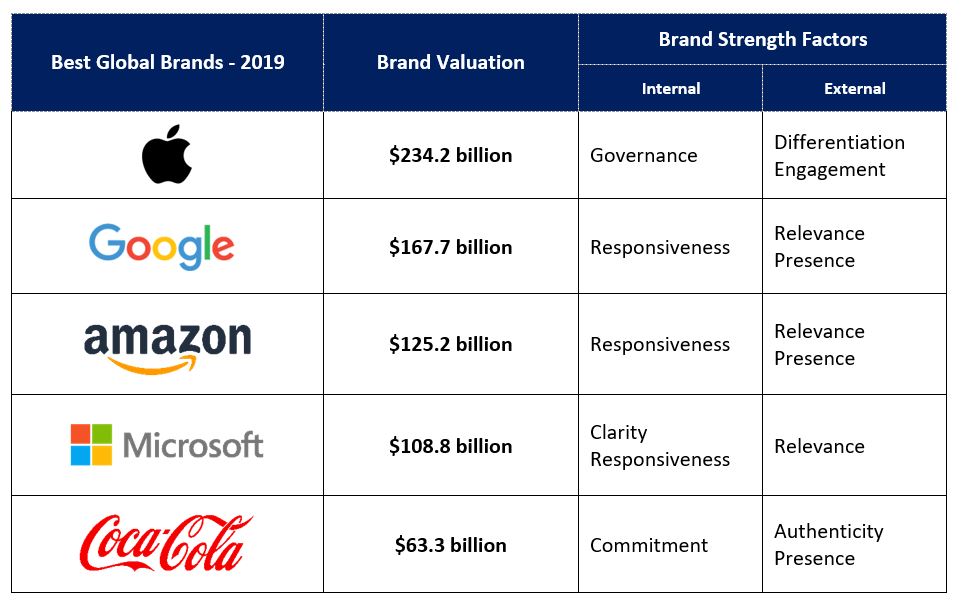
“It takes 20 years to build a reputation and five minutes to ruin it. If you think about that, you’ll do things differently.”
Warren Buffett
Brand Audit
A brand audit provides an analysis of a brand’s value effectiveness, as compared to the competition, and identifies any gaps among the brand and the company’s values and Strategic Alignment Model. Brands tend to get less and less germane over time and require an update at appropriate times. But how does management know their market image is weakening and demands a brand revisit, analysis, and improvement?
Many businesses fail to adapt their corporate brand’s character in response to economic developments, competition, and regulatory factors on a timely basis, thus letting the brand become dated and useless. Nonetheless, there is an array of telling warnings that signal that it is indeed time for a brand audit, including:
- Attract unsuitable customer types.
- Change in company culture and behaviors.
- Improved competition.
- New and changed governmental regulations.
- Noticeable customer changes in behaviors and preferences.
- Obsolete or unconvincing value proposition.
- Risks to economy impacting targeted industry segments.
- Unaligned corporate look and function.
- Unforeseen revenues and profitability loss.

A brand audit is a key strategic tool that can provide the management team a current view of the corporate image in the market with the below outcomes:
- Determine the organizational brand strength from the market perception of the image weaknesses, inconsistencies, and opportunities for enrichment.
- Establishes a brand benchmark for future comparison.
- Identifies the basis for positioning the brand.
- It offers insights into how brand equity may be strengthening.
The objective of a brand audit is to identify specific actions to improve the brand. In this regard, the essential findings and conclusions should be balancing with a pragmatic improvement project, and resourcing plans to execute.
“Brand is just a perception, and perception will match reality over time.”
Elon Musk
The Way Forward
At Knowledge Compass we bring together nearly four decades of thought leadership in business and technology strategy, the latest tools and best practices, and a seasoned consultant team with the competencies and talent to help our clients improve productivity and profitability of all enterprise business and support activities.
Knowledge Compass explores and develops valuable new insights from business, technology, and science by embracing the powerful technology of ideas and brainstorming. Our consultants engage customers in challenging discussion and experimentation to expand the boundaries of business science and practice and translate creative ideas into practical solutions from within and beyond business.
Working with Knowledge Compass means a collaborative approach to understanding your current business model, strategies, and key business requirements and goals.
Knowledge Compass provides consulting services with the use of an array of Frameworks, Analyses Tools, and Interactions from their Best Practices Consultant Toolbox.